Lab Research
The Human Performance and Biodynamics Laboratory (HPB Lab) is a state of the art facility with advanced technology, frequently used for conducting scientific research. The lab is home to cutting-edge equipment that is capable of analyzing precise measurements and characteristics surrounding human movement and postural control in a wide variety of populations such as pediatrics, older adults, athletes, individuals with neurologic disorders, individuals with musculoskeletal abnormalities, etc. Through collaborative efforts within departments at WSSU and WFU, as well as with external universities, healthcare systems, military organizations, product development industries, and other institutions, research study data collection and data processing protocols are performed in the HPB Lab, often leading to the production of scholarly works in the form of peer-reviewed abstracts, oral and poster presentations, symposiums, and publications.
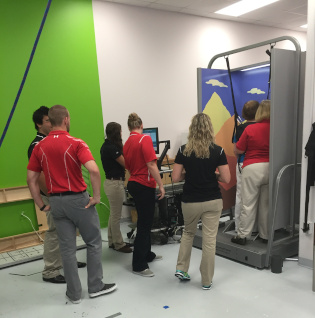 Student Involvement
Student Involvement
Students from Winston-Salem State Department of Physical Therapy and Wake Forest School of Medicine Department of Orthopaedic Surgery complete research projects in the lab. Faculty mentors help the students learn about research design, data collection, analysis and interpretation. Upon the completion of their time in the lab, these projects are often presented at research symposiums held by local, regional, national, and international organizations such as: the WSSU Office of Student Research, the American Physical Therapy Association (APTA) North Carolina Chapter, the American College of Sports Medicine (ACSM), the American Academy of Orthopaedic Surgery (AAOS), the American Society of Biomechanics (ASB), and the World Congress of Biomechanics (WCB).
This study sought to test the hypothesis that cruciate-retaining (CR) total knee arthroplasty (TKA) will facilitate improved early functional outcomes in gait compared with posterior-substituting (PS) TKA. No significant difference in spatiotemporal, kinematic, or kinetic parameters between groups was detected, but there was a trend toward quadriceps overuse gait pattern in the CR group. Patients undergoing TKA with a PS implant were more willing to engage in regular higher level physical activity. The CR implant may be a risk factor for quadriceps overuse gait pattern, while the PS implant may be protective against quadriceps overuse.
Brown ML, Wendt CS, Seyler TM, Ip EH, Foxworth JL, Lang JE. Gait and Functional Outcomes Between Cruciate-Retaining and Cruciate-Substituting Implants in Total Knee Arthroplasty: A Prospective, Randomized Study. J Surg Orthop Adv. 2019;28(3):215‐223.
The generation of hip torques from the hip musculature is an important aspect of the golf swing. Golf is a very popular activity, and estimates of hip torques during the golf swing have not been reported. The purpose of this study was to compare the 3-D hip torques during a golf swing between young and senior healthy male amateur golfers. The secondary purpose was to compare the 3-D hip joint torques between the trail leg and lead leg. Trail-limb hip external rotator torque was significantly greater in the younger group compared to the senior group, and greater in the trail leg versus the lead leg. When adjusting for club-head velocity, young and senior healthy male amateur golfers generated comparable hip torques during a golf swing, with the exception of the trail-limb hip external rotator torque. The largest hip torque found was the trail-limb hip extensor torque.
Foxworth JL, Millar AL, Long BL, Way M, Vellucci MW, Vogler JD. Hip joint torques during the golf swing of young and senior healthy males. J Orthop Sports Phys Ther. 2013;43(9):660‐665. doi:10.2519/jospt.2013.4417
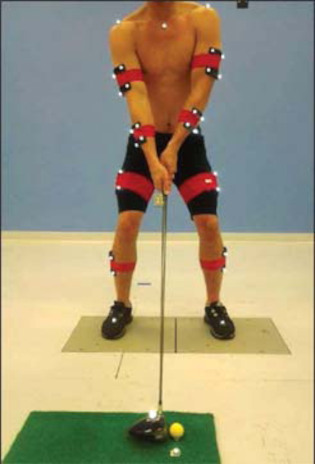
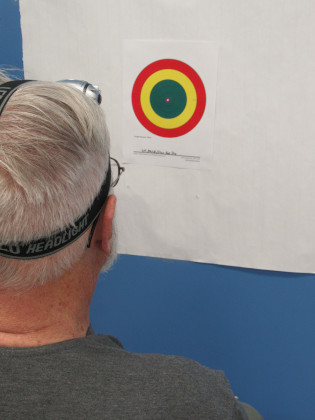 Forward Head Posture (FHP) is a commonly observed postural defect in the geriatric population. Incidence of forward head posture deviation increases with age and is linked to increased number of falls. Explanations for this relationship have included changes in cervical anticipatory postural adjustments, altered head and neck position sense, vestibular deficits, and physical functional difficulties such as rising from a chair. The purpose of this study was to determine the relationship between fall risk and forward head posture as measured by several tests, in independent, community-dwelling older adults.
Forward Head Posture (FHP) is a commonly observed postural defect in the geriatric population. Incidence of forward head posture deviation increases with age and is linked to increased number of falls. Explanations for this relationship have included changes in cervical anticipatory postural adjustments, altered head and neck position sense, vestibular deficits, and physical functional difficulties such as rising from a chair. The purpose of this study was to determine the relationship between fall risk and forward head posture as measured by several tests, in independent, community-dwelling older adults.
The 'Limit of Stability' (LOS) is the area in which the position of the center of mass/gravity (COM/COG) is controlled without moving the base of support. Decreased stability limits are a major risk factor for falls, and negatively impact dynamic functional activities involving weight-shifting and voluntary sway. An accurate, sensitive computerized forceplate test of the LOS® has been available for 20 years, but adoption has been hampered by perceived cost. The Functional Reach Test (FR) was developed as a low-cost, low-tech LOS test for home use, but the FR does not measure LOS or predict fall risk. The FR requires trunk motion, but not necessarily shifts of the COM/COG. The Sway Sled® (SS) is a recently developed, low-cost, reliable and valid test of LOS that requires COM shifts, with good retrospective fall risk prediction. The purpose of this study was to compare kinematic measures of the postural movement strategies used to accomplish these three tests. We hypothesized that FR scores are achieved with trunk motion in the absence of COM/COG motion, while LOS® and SS® scores are achieved with COM/COG motion.
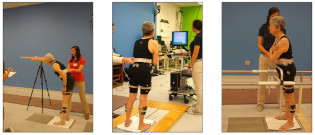
The primary objective of this study is to decrease the number of falls in community dwelling elderly African-Americans with hypertension. The effect of falls can include physical limitations, increased cost of care or even death. This study will help with identification of those elderly African-Americans who are at high risk for falls. This study will offer a basis for developing fall prevention programs to help community dwelling elderly African-Americans maintain independent living and a better quality of life for as long as possible.
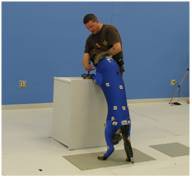 The purpose of this project is to incorporate multi-slice CT, motion capture, and computer animation to model joint movements in these working dogs. With the information gained from this work, we hope to provide early detection and treatment to minimize loss of man-hours, financial investment, and mission readiness.
The purpose of this project is to incorporate multi-slice CT, motion capture, and computer animation to model joint movements in these working dogs. With the information gained from this work, we hope to provide early detection and treatment to minimize loss of man-hours, financial investment, and mission readiness.
Stubbs AJ, Anz A, Long B, Frino J, Cheetham S, Tanaka, ML, "Physical Evaluation of Hip Pain in Non/Pre-Arthritic Patient and Athlete: a Video Exam with Computer Generated Model", American Academy of Orthopaedic Surgery Annual Meeting, March 9-13, New Orleans, LA, (2010).
